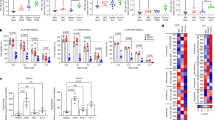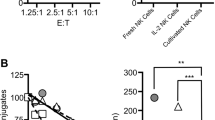Abstract
As natural killer (NK) cell activity is an essential constituent of host defence systems1 and reactive oxygen intermediates participate in such defence2–4, the effect of scavengers of oxygen radicals on NK cell activity was investigated. Hydroxyl radical (OH·) scavengers5 (dimethyl sulphoxide (DMSO), thiourea, dimethylurea, tetramethylurea, benzoic acid, ethanol, methanol and ethylene glycol) inhibited NK cell activity. Catalase, a scavenger of H2O2, and Superoxide dismutase (SOD), a scavenger of O−2, either alone or in combination, did not inhibit NK cell activity. Inhibition of the lipoxygenase pathway of arachidonic acid metabolism, a potential source of cellular OH·, with nordihydroguaiaretic acid6 and 5,8,11,14-eicosatetraynoic acid (ETYA)7 resulted in marked inhibition of NK cell activity. Inhibition of the cyclooxygenase pathway7,8 with acetylsalicylic acid or indomethacin had minimal effects on NK cell activity. Taken together, these findings suggest that OH·, possibly generated via the lipoxygenase pathway of arachidonic acid metabolism, is critical for NK cell cytotoxicity.
This is a preview of subscription content, access via your institution
Access options
Subscribe to this journal
Receive 51 print issues and online access
$199.00 per year
only $3.90 per issue
Buy this article
- Purchase on Springer Link
- Instant access to full article PDF
Prices may be subject to local taxes which are calculated during checkout
Similar content being viewed by others
References
Herberman, R. B. NK Cells and Other Natural Effector Cells (Academic, New York, 1982).
Babior, B. M. New Engl. J. Med. 298, 659–668, 721–725 (1978).
Klebanoff, S. J. Semin. Hemat. 12, 117–142 (1975).
Badwey, J. A. & Karnovsky, M. L. A. Rev. Biochem. 49, 695–726 (1980).
Dorfman, L. M. & Adams, G. E. Natn. Stand. Ref. Data Serv. U.S.A. 46, 1–59 (1973).
Tappel, A. L., Lundberg, W. & Boyer, P. D. Am. Biochem. Biophys. 42, 293–304 (1953).
Ahern, D. G. & Downing, D. T. Biochim. biophys. Acta 210, 456–461 (1970).
Flower, R. J. Pharmac. Rev. 26, 33–67 (1974).
Roder, J. C. et al. Immunology 40, 107–116 (1980).
Suthanthiran, M. et al. Regulatory Mechanisms in Lymphocyte Activation (ed. Lucus, D. O.) 362–364 (Academic, New York, 1976).
Novogrodsky, A., Ravid, A., Rubin, A. L. & Stenzel, K. H. Proc. natn. Acad. Sci. U.S.A. 79, 1171–1174 (1982).
Fridovich, I. Science 201, 875–880 (1978).
Haber, F. & Weiss, J. Proc. R. Soc. A147, 332–351 (1934).
Roder, J. C. et al. Nature 298, 569–572 (1982).
Kuehl, F. A. Jr & Egan, R. W. Science 210, 978–984 (1980).
Hoffman, J. et al. Proc. natn. Acad. Sci. U.S.A. 78, 3839–3843 (1981).
Henderson, W. R., Chi, E. Y., Jorg, A. & Klebanoff, S. J. Am. J. Path. 111, 341–349 (1983).
Carpen, O., Virtanen, I. & Sakesla, E. Cell Immun. 58, 97–106 (1981).
Quan, P. C., Ishizaka, I. & Bloom, B. R. J. Immun. 12 B, 1786–1791 (1982).
Fong, K. L., McCay, P. B., Poyer, J. L., Keele, B. B. & Misra, H. J. biol. Chem. 248, 7792–7797 (1973).
Mittal, C. K. & Murad, F. Proc. natn. Acad. Sci. U.S.A. 74, 4360–4364 (1977).
Haddox, M. K., Stephenson, J. H., Moser, M. E. & Goldberg, N. D. J. biol. Chem. 253, 3143–3152 (1978).
Suthanthiran, M., Stenzel, K. H., Rubin, A. L. & Novogrodsky, A. Cell Immun. 50, 379–391 (1980).
Timonen, T. & Saksela, E. J. immunol. Meth. 36, 285–291 (1980).
Novogrodsky, A., Rubin, A. L. & Stenzel, K. H. J. Immun. 122, 1–7 (1979).
Li, C. Y., Lam, K. W. & Yam, L. T. J. histochem. Cytochem. 21, 1–12 (1973).
Author information
Authors and Affiliations
Rights and permissions
About this article
Cite this article
Suthanthiran, M., Solomon, S., Williams, P. et al. Hydroxyl radical scavengers inhibit human natural killer cell activity. Nature 307, 276–278 (1984). https://doi.org/10.1038/307276a0
Received:
Accepted:
Issue Date:
DOI: https://doi.org/10.1038/307276a0
This article is cited by
-
Mechanisms regulating immune surveillance of cellular stress in cancer
Cellular and Molecular Life Sciences (2018)
-
Effects of lipoxygenase and cycloxygenase inhibitors on murine antibody-dependent cellular cytotoxicity (ADCC)
Research in Experimental Medicine (1992)
-
Generation of lymphokine activated killer cells in a new high density dialyzing culture apparatus
Cytotechnology (1989)
-
Platelets mediate the action of diethylcarbamazine on microfilariae
Nature (1987)
-
Cell-mediated cytotoxicity by natural killer and killer cells, lipid peroxidation and glutathione
Experientia (1986)
Comments
By submitting a comment you agree to abide by our Terms and Community Guidelines. If you find something abusive or that does not comply with our terms or guidelines please flag it as inappropriate.



